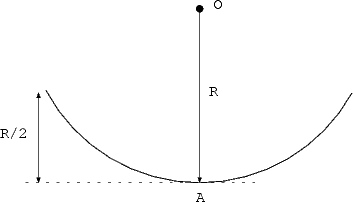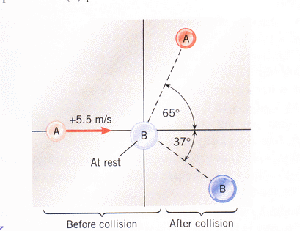1. (5 points) Consider an equation v =  zxt2 where v is a linear velocity, x is the
displacement, and t is the time. What is the unit of the parameter z?
zxt2 where v is a linear velocity, x is the
displacement, and t is the time. What is the unit of the parameter z?
2. (5 points) A luggage can be dragged up to the top of a small hill. It can also be hanging straight down from your hand as you walk up to the top of the small hill. In which case is the work done by the force exerted by your hand on the luggage larger? Explain.
3. (5 points) An electric clock is hanging on the wall. The clock is unplugged and the second hand comes to a halt over a brief period of time. During this period, what is the direction of the angular acceleration of the second hand? Draw a sketch to show your result.
4. (10 points) A spelunker drops a stone from rest into a hole and the sound of the stone striking the bottom of the hole is heard 2s later. The speed of the sound in air is 340m/s. The hole is vertical. How deep is the hole?
5. (20 points) A placekicker kicks a football at an angle of  = 30o above the horizontal axis. The
initial velocity of the ball is 20m/s. Ignore air resistance.
= 30o above the horizontal axis. The
initial velocity of the ball is 20m/s. Ignore air resistance.
(a) (5 points) Find the maximum height H that the ball attains.
(b) (5 points) Find the time of flight between kickoff and landing of the ball.
(c) (5 points) Find the range of the kickoff.
(d) (5 points) Find the velocity (magnitude and direction) of the ball just prior to hitting the ground.
6. (20 points) A block of mass m = 1kg is placed on a slope at an angle of  = 15o
above the horizontal surface. The static friction coefficient and the kinetic friction
coefficient between the block and the slope are
= 15o
above the horizontal surface. The static friction coefficient and the kinetic friction
coefficient between the block and the slope are  s = 0.5 and
s = 0.5 and  k = 0.2 respectively.
k = 0.2 respectively.
(a) (5 points) Draw the free body diagram for the block.
(b) (10 points) Find all the forces acting on the block.
(c) (5 points) The block will stay on the block. Prove this claim.

7. (25 points) A skier starts from rest and coasts down a circular track shown in the figure. The radius of the circular track is R = 10m. The starting point is R/2 above the lowest point A of the circular track. The circular track is frictionless. The mass of the skier is m = 50kg.
(a) (5 points) Is the mechanical energy of the skier conserved? Explain.
(b) (5 points) Find the velocity of the skier at the lowest point A.
(c) (5 points) What is the centripetal acceleration of the skier at A?
(d) (5 points) What is the tangential acceleration of the skier at A?
(e) (5 points) Find the normal force acting upon the skier at A.

8. (20 points) The drawing shows a collision between two pucks on an air-hockey table. Puck A has a mass of 0.025kg and is moving along the x axis with a velocity of +5.5m/s. It makes a collision with puck B, which has a mass of 0.05kg and is initially at rest. After the collision, the two pucks fly apart with the angles shown in the figure. Find the final speed of puck A and B.
